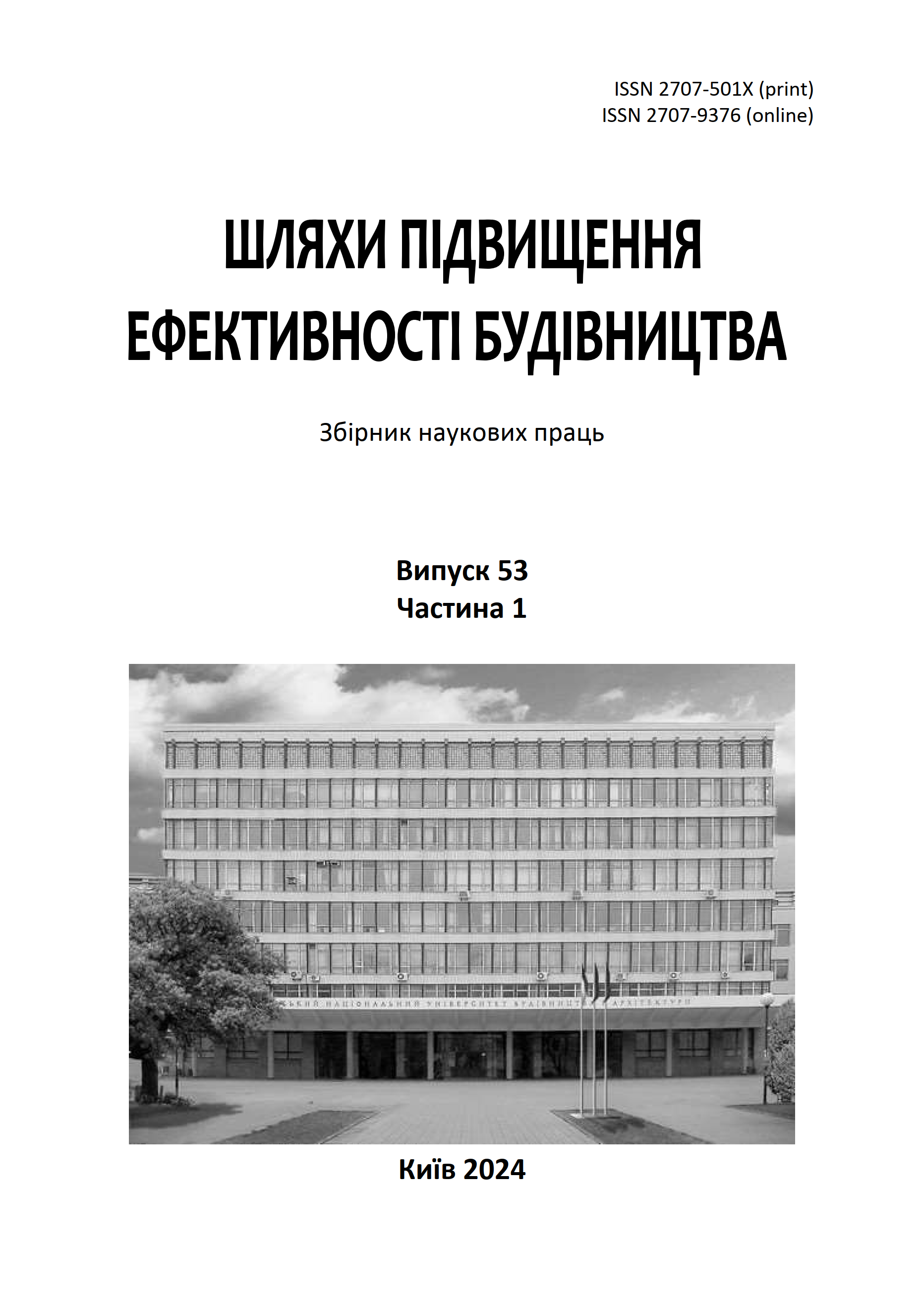Numerical study of the stability of a shell of minimal surface on a circular plan with regard to geometric nonlinearity under thermal and power loading
DOI:
https://doi.org/10.32347/2707-501x.2024.53(1).39-48Keywords:
shell stability, multicriteria parametric optimization, minimum surface shell, calculation of shell stability, geometric nonlinearity, nonlinearity, thermal loads, power loads, static loads, thermal and power loadsAbstract
Great progress has been made in the field of thin elastic shells calculation, both in the field of mathematical theory, which, based on the Kirchoff-Love hypothesis in surface theory, is engaged in the construction of various forms of important design equations and the development of accurate methods for their solution, and in the field of structural and applied mechanics, which is based on the specified initial parameters and accepted additional working hypotheses, which are determined by experimental data, and which deals with simplification of calculation schemes and methods of their solution, which will be convenient for engineering calculations.
The geometric nonlinearity of the equations is achieved by taking into account the quadratic term in the expressions of the component of the membrane deformation tensor and changes in the deformed shape of the middle surface of the shell. The solution of the system of nonlinear equations is constructed by the iterative method of continuation of the solution in the parameter, taking into account the Newton-Kantorovich method.
When operating thin shells, they can be subjected to harsh conditions - under the influence of various temperature and force loads. Large, inhomogeneous temperature fields affect the mechanical properties of the material and can cause large deformations, and can be the most determining factor affecting the strength and load-bearing capacity of the shell as a whole.
Geometrically nonlinear problems are mainly used to formulate structural stability problems. In most cases, the stability problem can be solved by reducing it to a linear formulation under natural oscillations.
Geometrically nonlinear problems are problems of elasticity theory in which nonlinearity in the dependence of strains and displacements is taken into account, while stresses and strains are related linearly. Taking into account nonlinear components of deformations is necessary for the calculation of flexible thin-walled structures.
In the numerical experiment, the eigenvalues of the stability factor are equal to 1.013, which means that there is no margin of safety and stability in the shell, and we can further use these results for multicriteria parametric optimization, and the results of the study are confirmed by the authors' methodology for objects where optimization of the shell geometry is taken into account.
References
Герасимов, Е.Н., Почтман Ю.М., Скалозуб В.В. Многокритериальная оптимизация конструкций. Київ: Вища школа, 1985. 134 с.
Гилл Ф., Мюррей У., Райт М. Практическая оптимизация. М.: Мир, 1985. 509 с.
Ігнатишин М.І. Механіко-математичне моделювання елементів мостових конструкцій (опора, балка, плита): монографія. Мукачево: РВВ МДУ, 2017. 172 с.
Іванченко Г.М., Кошевий О.О., Кошевий О.П. Чисельна реалізація багатокритеріальної параметричної оптимізації оболонки мінімальної поверхні на квадратному контурі при термосиловому навантаженні. Опір матеріалів і теорія споруд. 2022. Вип. 109. С. 50-65. DOI: 10.32347/2410-2547.2022.109.50-65
Іванченко Г.М., Кошевий О.О., Кошевий О.П., Григор’єва Л.О. Чисельне дослідження параметричної оптимізації вимушених частот коливання оболонки мінімальної поверхні на трапецевидному контурі при термосиловому навантаженні. Опір матеріалів і теорія споруд. 2023. Вип. 110. С. 430-446. DOI: 10.32347/2410-2547.2023.110.430-446
Іванченко Г.М., Кошевий О.О., Жупаненко І.В. Оптимальне проектування вимушених частот коливання оболонки мінімальної поверхні на круглому контурі, яка складається із двох похилих еліпсів при термосиловому навантаженні. Шляхи підвищення ефективності будівництва в умовах формування ринкових відносин. 2023. № 51. С. 218-233. DOI:10.32347/2707-501x.2023.51(1).218-233
Yurchenko V., Peleshko I. Searching for a compromise solution in cross-section size optimization problems of cold-formed steel structural members. Опір матеріалів і теорія споруд. 2022. Вип. 109. С. 72-92. DOI: 10.32347/2410-2547.2022.109.72-92
Peleshko I., Yurchemko V. Optimization of cross-section dimensions of structural members made of cold-formed profiles using. Eastern-European Journal of Enterprise Technologies. 2022, Vol. 119, Issue 7, p. 84-95. DOI: 10.15587/1729-4061.2022.261037
Yurchemko V., Peleshko I. Optimal numbers of the redundant members for introducing initial pre-stressing forces into steel bar structures. Опір матеріалів і теорія споруд. 2021. Вип. 106. С. 68-91. DOI: 10.32347/2410-2547.2021.106.68-91
Yurchenko V. Searching for shear forces flows in arbitrary cross-sections of thin-walled bars: numerical algorithm and software implementation. Опір матеріалів і теорія споруд. 2019. Вип. 103. С. 82–111.
Yurchenko V.V., Peleshko I.D. Parametric optimization of steel lattice portal frame with chs structural members. Опір матеріалів і теорія споруд. 2021. Вип. 107. С. 45-74. DOI: 10.32347/2410-2547.2021.107.45-74
Perelmuter A., Yurchenko V., Peleshko I. Optimization of cross-sectional dimensions for cold-formed steel lipped channel columns. Опір матеріалів і теорія споруд. 2022. Вип. 108. С. 156-170. DOI: 10.32347/2410-2547.2022.108.156-170
Yurchenko V.V., Peleshko I.D. Parametric optimization of steel structures based on gradient projection method. Опір матеріалів і теорія споруд. 2020. Вип. 105. С. 192-220. DOI: 10.32347/2410-2547.2020.105.192-220
Кривошапко С.В., Иванов В.Н., Халаби С.М. Аналитические поверхности: материалы по геометрии 500 поверхностей и информация к расчету на прочность тонких оболочек. М.: Наука, 2006. 544 с.
Downloads
Published
How to Cite
Issue
Section
License

This work is licensed under a Creative Commons Attribution 4.0 International License.
Authors who publish with this journal agree to the following terms:
- Authors retain copyright and grant the journal right of first publication with the work simultaneously licensed under a Creative Commons Attribution License that allows others to share the work with an acknowledgement of the work's authorship and initial publication in this journal.
- Authors are able to enter into separate, additional contractual arrangements for the non-exclusive distribution of the journal's published version of the work (e.g., post it to an institutional repository or publish it in a book), with an acknowledgement of its initial publication in this journal.
- Authors are permitted and encouraged to post their work online (e.g., in institutional repositories or on their website) prior to and during the submission process, as it can lead to productive exchanges, as well as earlier and greater citation of published work (See The Effect of Open Access).

